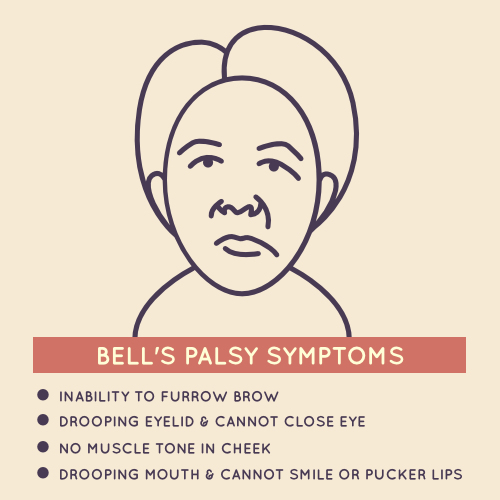Not familiar with Bell’s palsy? Here’s what you need to know.
What is Bell’s palsy?
Bell’s palsy causes temporary weakness or paralysis to the facial muscles, usually affecting just one side of the face, making it appear to have drooped. It’s the most common cause of facial paralysis but is still relatively rare, affecting one in 5,000 people a year, with both men and women equally likely to get it.
The severity’s said to vary from person to person; some feel a mild muscle weakness and others have no movement at all. There can also be a sharp pain in the inner ear as the paralysis starts, sensitivity to loud noise, difficulty closing the eyes, an impaired sense of taste and difficulty pronouncing sounds and letters like ‘B’ and ‘P’ if the condition affects the mouth.
Each side of the face has its own facial nerve, so damaging the left side will only affect the left side of the face for example, but in very rare cases paralysis can occur on both sides.
Why does it happen?
Doctors believe Bell’s palsy occurs when facial nerves, that go through a narrow gap of bone near the jawline on their way to the brain, became compressed or inflamed. This can happen if the blood or oxygen supply to the nerve cells are restricted – but the exact cause of this is actually unknown.
Links have been made between viral conditions, such as the herpes simplex virus (which causes cold sores and genital herpes) or the varicella-zoster virus (which causes chickenpox), Lyme disease, as well as a depleted immune system and prolonged stress.

Can anyone get Bell’s palsy at anytime?
The charity Facial Palsy UK says people aged 15-45 are most likely to develop Bell’s palsy, and that women in the third trimester of pregnancy can be at increased risk. People who have diabetes or HIV are said to be at a higher risk too, and there appears to be a higher incidence of the condition in the UK in winter.
It can come on very suddenly though, with no warning. The charity say it usually peaks after 72 hours and that in eight out of 10 cases, it will disappear within nine months.
Are there any treatments?
The NHS recommended treatment is Prednisolone – a steroid which helps to prevent inflammation. Facial exercises and Botox injections, to relax the muscles, may also help.
Angelina Jolie, who developed Bell’s palsy and other health issues after her stressful split with Brad Pitt, said acupuncture helped her recovery, and she’s not the only one to credit the alternative therapy as being beneficial.
Traditional acupuncturist Angela Wallis says lots of people choose acupuncture for health problems like Bell’s palsy “because it’s completely natural and safe”.
She says: “In Chinese medicine terms, it’s really important to start traditional acupuncture as soon as possible after a diagnosis of Bell’s palsy to get the best results. We would expect to see an improvement in symptoms after four to six treatments if treated early – weekly is best. Traditional Acupuncture has been proven by clinical research to stimulate muscles and nerves in the face, improve blood flow to the area and reduce inflammation of the nerves.”
Catriona Neville, a specialist facial palsy rehabilitation therapist at Queen Victoria Hospital, East Grinstead, says it’s important all patients with facial palsy seek treatment within the first 72 hours, as steroid treatment’s most effective if administered within this time-frame.
Catriona adds: “There is some evidence that acupuncture can be helpful in addition to steroids, however the evidence for this is limited and often anecdotal. Many people mistakenly assume that treatments help them recover, when in fact 60-70% of patients will make a spontaneous recovery anyway. Steroids have been proven to increase the likelihood of spontaneous recovery.
“For patients left with complications after facial palsy, such as synkinesis [involuntary movement], specialist therapy and Botox have been shown to be successful in improving outcomes.”
Mindful breathing exercises – how to reduce stress and anxiety.
































































